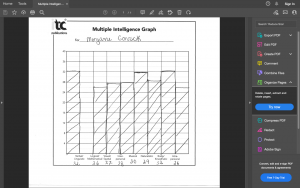I found this sheet really interesting because it addresses just how important it is to give detailed feedback for student and teacher purposes. Feeback will be beneficial to keep in mind when assessing students’ work, whether formative or summative.
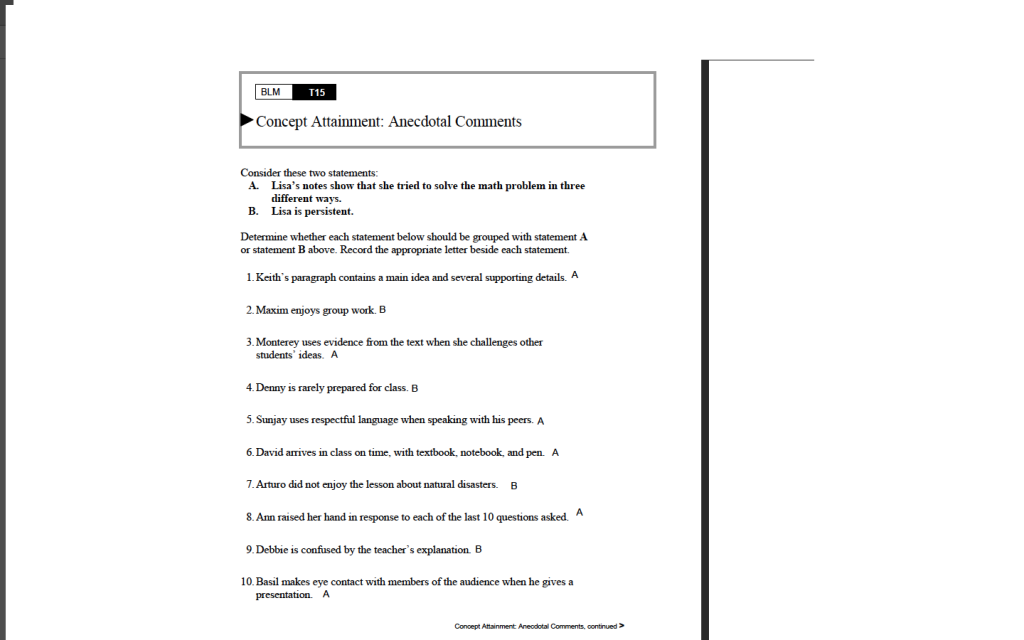

I found this sheet really interesting because it addresses just how important it is to give detailed feedback for student and teacher purposes. Feeback will be beneficial to keep in mind when assessing students’ work, whether formative or summative.


We were presented with an image of the Métis flag and given 2 minutes to write what we know about the topic without using any form of research. When my partner and I compared and gave feedback we noticed that though our answers were similar there were areas that we brought to the forefront. For example, we both acknowledged the infinity symbol but we described the meaning behind it. Another example is we both wrote that Métis people can be linked to Indigenous peoples and European peoples; my buddy used the example French while I chose a wider range. This is certainly a form of assessment I would use in my classroom.
My Example
At the center of the Métis, the flag is an infinity symbol, with a blue background. Prior to the creation of the blue flag, the background was red, usually associated with the Metis sash which is mostly red in colour. The Métis nation can trace its roots back to the Red River Valley in Manitoba and parts of Sask after the Manitoba act. The flag is often brought up in conversations about the “Real Métis”. There are people on the east coast who have put forth evidence that they are the offspring of Fur traders and Indigenous peoples. They argue that the infinity symbol should be a sign of unity not divide.
Buddy Example
This picture is of a Métis flag. The flag is an Infinitiy symbol that symbolizes unitedness and connectedness as the symbol does not have a start or an endpoint. The flag is on a blue background which indicates the sky and how under treaty we are all on this land together. The Métis people are historically genetically half Indigenous and half French. The metis people have a holding in Treaty 4 where we currently reside in Regina.
Feeback and Observations
A similar understanding of the Métis flag and symbol. I appreciated that you used the reference to Treaty 4, as this is the homeland of the Metis, even though they are not included in the official Treaty documents. It seems like we both have a similar understanding and core understanding of the flag and Metis culture as a whole.
Fishbone organizers have come into discussion in previous classes but never something I have put into practice. My group had all heard about this but much like myself, we had not explored it further. The following is our Fishbone Organizer completed on February 3rd.
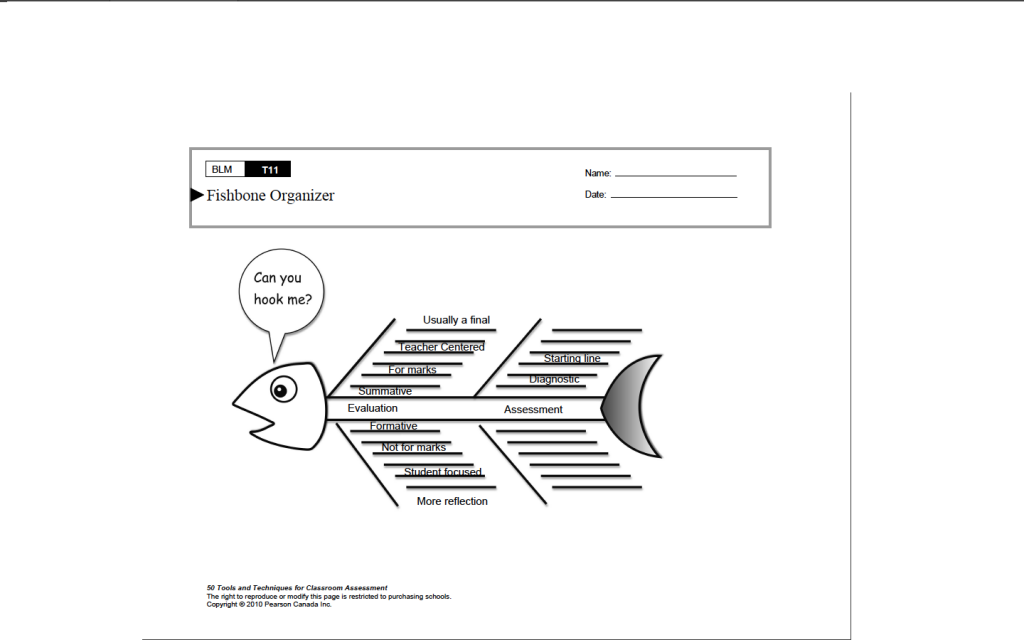
Here are the three Bloom Taxonomy activities completed on January 27th, 2022. It was helpful to have a detailed breakdown of how the taxonomy works from learning goals to exploring each of the levels.
Simpler and More Complex Content – Activity #1
For each of the following learning goal examples, write content question(s) for students that you would consider more complex and write content question(s) that you would consider simpler for the goal.
| Learning Goal # 1: | Students will be able to multiply two digit numbers by two-digit numbers. |
| More Complex: | 87×14= 1,218 |
| Simpler Content | 10×10= 100 |
| Learning Goal # 2: | Students will be able to label the world’s continents on a map. |
| More Complex: | Drawing continents and label them |
| Simpler Content | Fill in the blanks or matching countries to territories |
| Learning Goal # 3: | Students will be able to sing with the correct tempo and pitch. |
| More Complex: | Matching the key on the piano/ ensuring small group members have the same tempo and pitch |
| Simpler Content | Practice O’Canada |
Formative Assessment & Standards-Based Grading, Robert Marzano (2010), Page 53
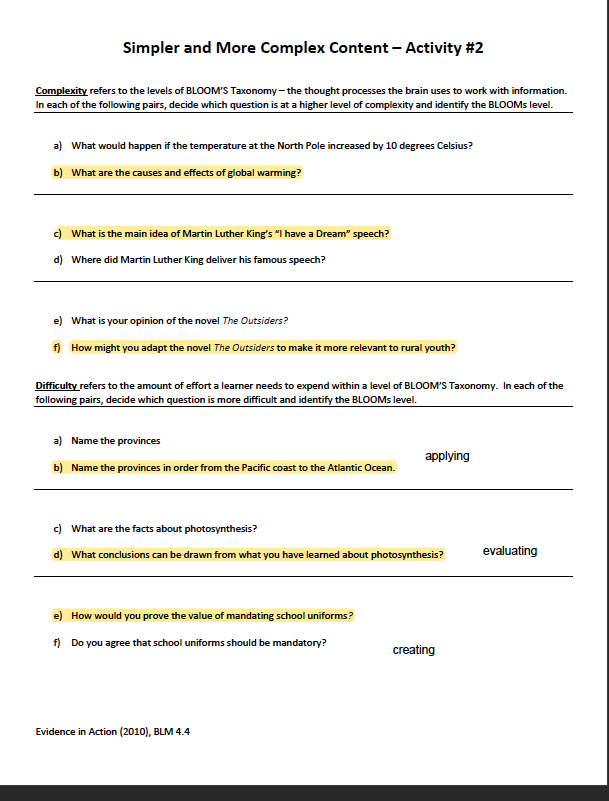
Creating Questions Using BLOOMS Recording Sheet – Activity #3
Topic: Red River Cart
| BLOOM’s | Question: |
| Remembering | -Who used Red River Carts? |
| Understanding | -What is a Red River Cart?-What is/was the importance of the Red River Car to the Métis? |
| Applying | Explain why the Red River Cart Trail was important? |
| Analyzing | -compare and contrast the usability. effectiveness and reputation of the Red River Cart with other forms of transportation at that time |
| Evaluating | -use the previous comparison to rank the various methods of transportation use a minimum of three and explain how you ranked them. |
| Creating | -Come up with a proposal for a method of transportation that would be just as effective |
The link below is a copy of the Personal Learning Goal I have created.
https://docs.google.com/document/d/1bFwHdRTnL4QPio-nQNBj_cFCvQ2X8ZW01b8B75Bc5Y4/edit?usp=sharing
Assessment is a partnership between educator and learner. Teachers are the ones presenting the assessment, but students need to understand what it is they are being assessed on and how it can further their learning.
I will admit before I began my education journey with the faculty of education, I just assumed assessment was a tedious task that students and another mark to add to your report card, (yes, I was rather cynical in my younger years). However, with age and education, it became very clear that assessment is much more than just right answers and marks. In short, there is always is or rather should have a purpose. It is our job as educators to make sure students understand the purpose of the assessment. Otherwise, it is rather difficult to fulfill the needs of students.
From my own experience sometimes it feels like you are trying to convince students there is a purpose to the task; not just something for them to do to waste time. Looking back I wish I would have collaborated more with students rather than just presenting them with a task that is supposed to assess their understanding. When I say group collaboration I don’t mean allowing students to call the shots but instead giving input into their strengths!
Goal setting is another area I find very critical to assessment. My main educational interest lies in the area of inclusive education and goal setting is a huge part of student assessment. Students will almost always have an IPP had is goals they intend to complete by a certain point. For example: by June 2022, Student A will be able to initiate a conversation with another student 50% of the time (this is pretty basic). I feel goal setting is not a bad idea for students in any classroom not just in intensive support settings. If possible have students set goals and continue to revisit these goals.
Below you will find a document exploring my own feelings and score in relation to the shared responsibility of assessment.

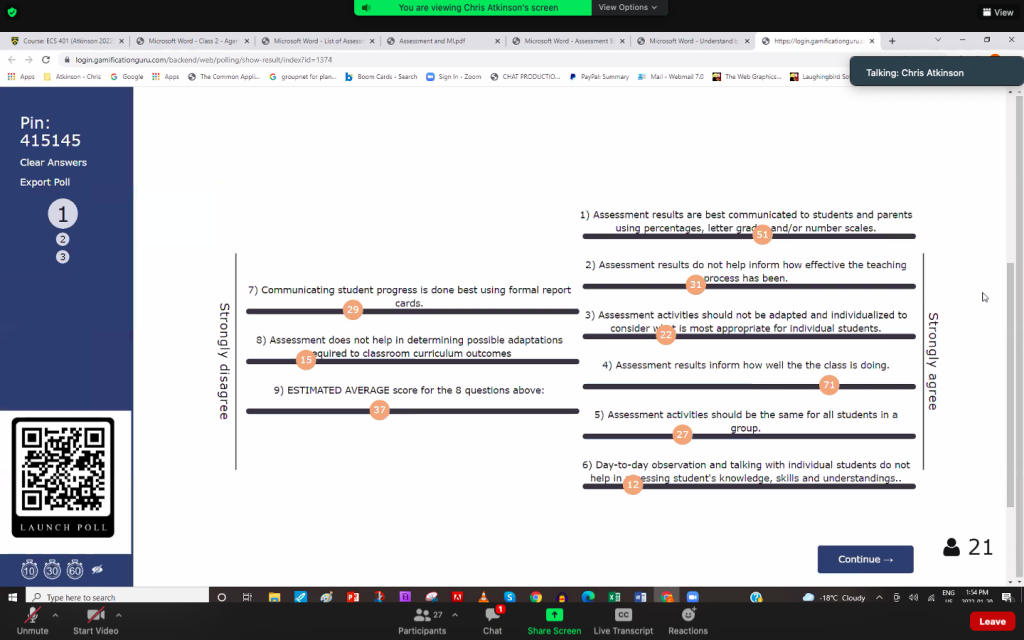
The following is a direct link to the learning circles completed by myself and group 2. As a group, we decided that it would be beneficial to jot down the main ideas from the text. I appreciate having discussions with classmates about readings because everyone brings a unique perspective to the group. The below link will be updated weekly with our weekly discussions and insights.
https://docs.google.com/document/d/1Vtqmp0MuCkwnodfh1iCkqiH2h8usGsXW8F_u1KWLqIM/edit
In addition to the link above you will find a weekly self-assessment of my participation in the first learning circle.


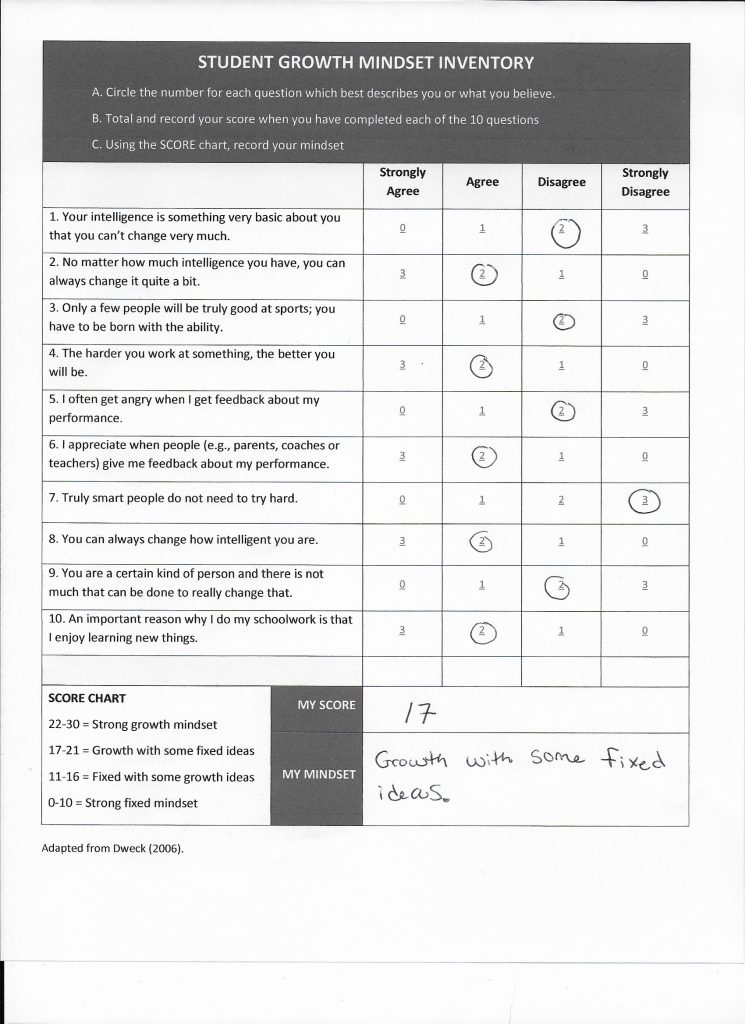
Though I have recently completed my internship, I will admit I am as familiar with assessment as it would seem. Part of my internship was spending 1 month in a mainstream social studies class where the summative and formative assessment was a big part of the class. The following gives a snapshot of where I find myself in the assessment world.
Section one: Where are we going?
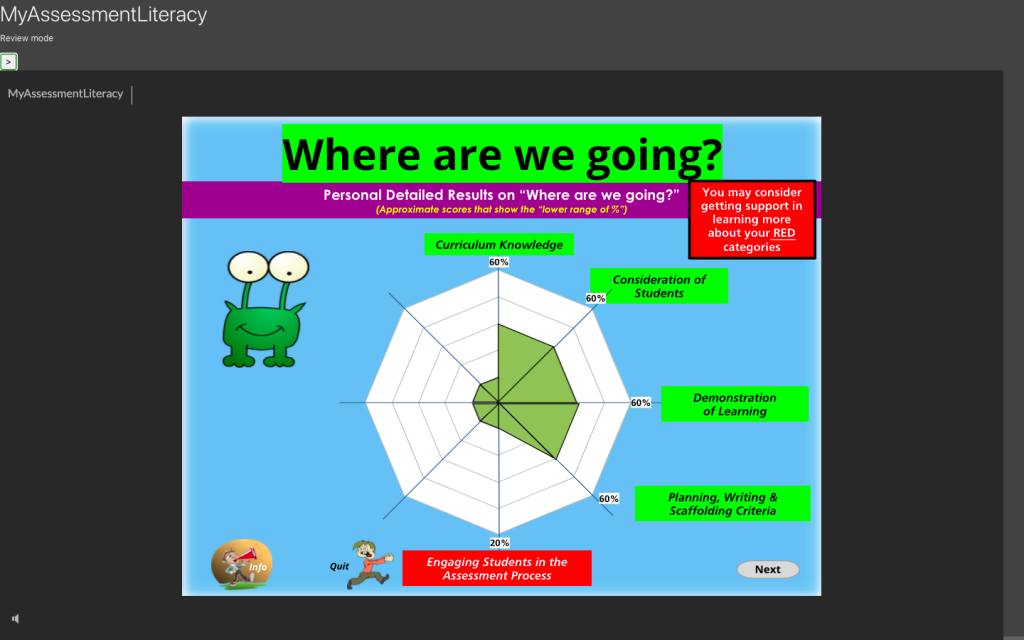
Section 2: How are we doing
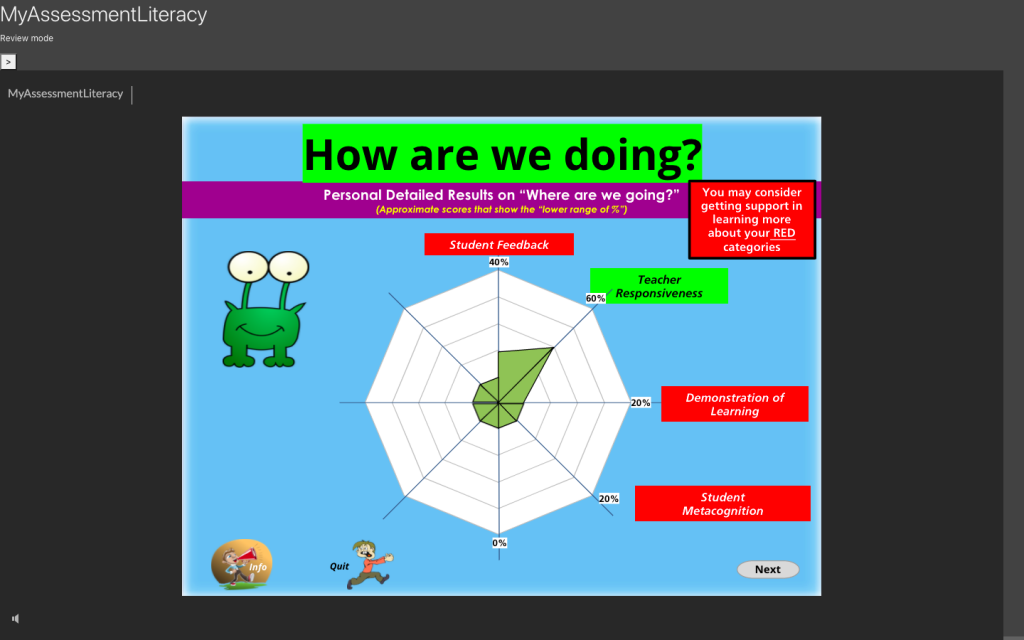
Section 3: Where to next?
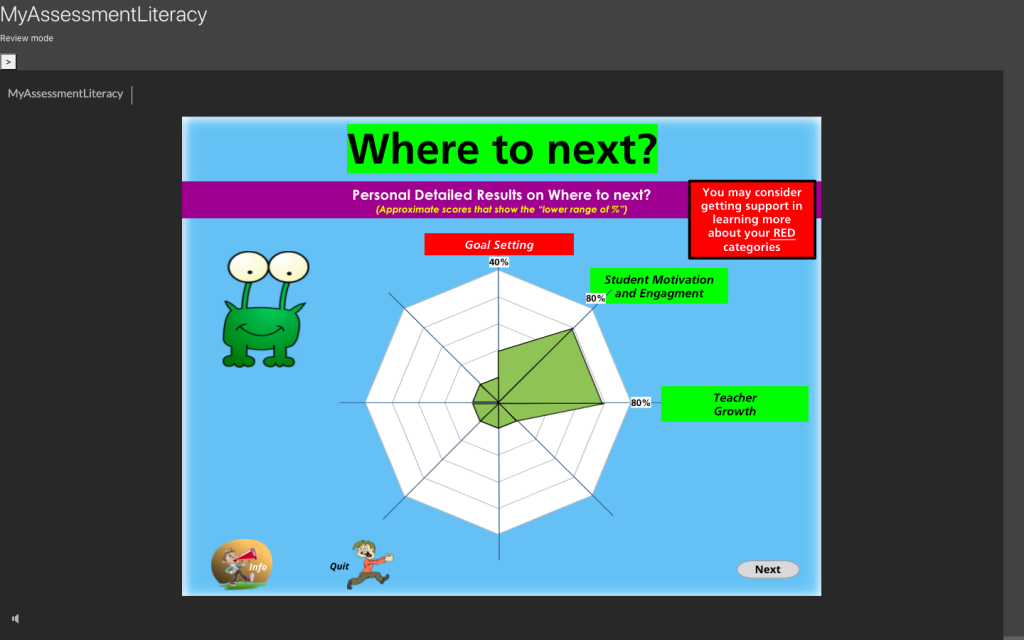
Section 4: Communicating with stakeholders
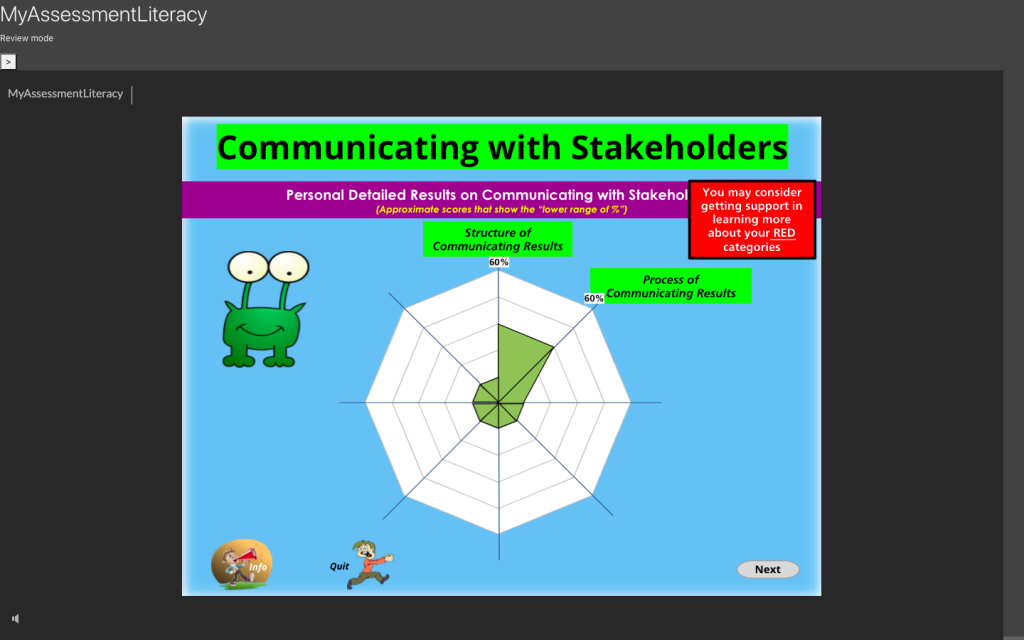
Section 5: System-based Assessment Literacy
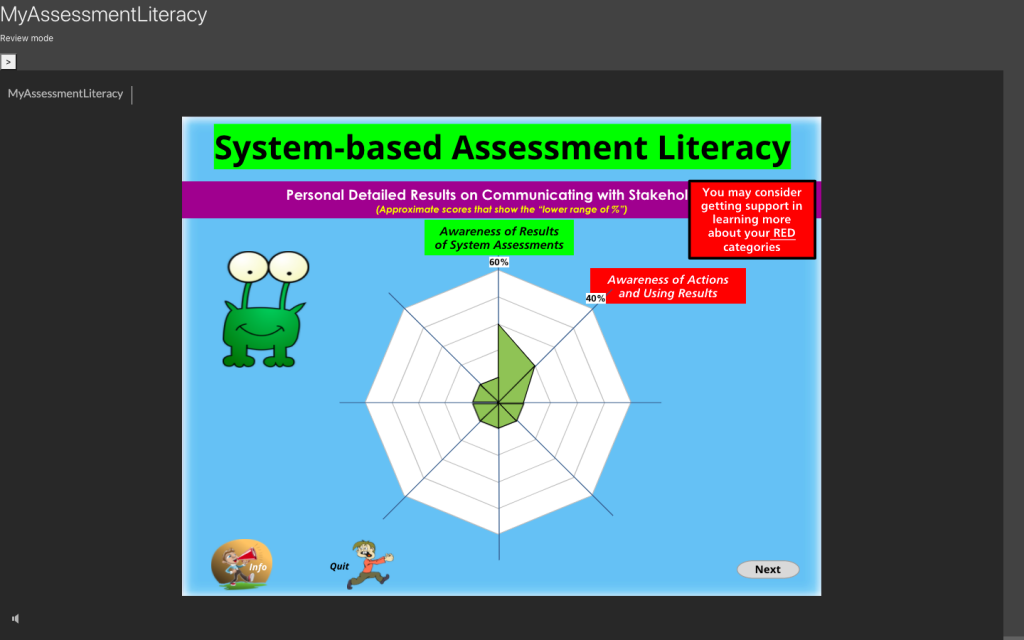
Final Section: Assessment Literacy

The Theory of Mulitple Intelligence explains how people learn and carry a variety of intelligence that they use in their day-to-day life. I had the opportunity to complete this quiz which was very eye-opening, more specifically when I saw it on a graph. I have always been very aware that I am a kinesthetic learner and use verbal skills very regularly in my day-to-day life. I actively seek activities that are of a linguistic nature! However, it was interesting to see how I scored on some of the sections. In the following, I will offer an explanation of my two highest scores and one that surprised me.
I scored 32 on the verbal/linguistic portion. This does not surprise me one bit, in fact despite my dislike of the subject English (the proper grammar part) I do enjoy exploring the English language and different words that I can use to describe something. This interest in language has fueled an interest in reading and writing as a pastime.
32 was also the score for the body/kinesthetic portion. Though not an extremely sports-driven person, I do enjoy moving and find it difficult to sit still. I notice when I teach, I find it nearly impossible to remain static, whether it be holding and dropping a whiteboard marker or moving around the classroom. It is rewarding to see our society being much more accepting that not everyone is able to remain seated or have “quiet hands” while they work. In recent years, I have seen a lot more accommodation such as wobbly chairs, rocking chairs, nondisruptive fidgets, and movement breaks. Looking back, this would have been something I feel I would have enjoyed as a student. Another thing is learning by touch. I will admit, I am that person that needs to touch everything at a store to process new information.
One that surprised me was my score in logical and mathematical. I scored 26 on this section. The reason this surprised me is my dislike for math, like my literal hatred of math. When I first read the title I thought, “I am going to have a very low score on this”. It is low compared to my other scores but what surprised me is the section was much more logical and organizational skills. I do not always practice organization but it does help me in many areas of my life. The only two areas I scored a one or no, the statement is not at all like me area was in I enjoy math and using numbers and I enjoy playing brain teasers and logic puzzles. This was really the only area in the section that referred to the topic of math.
You can find the complete chart below to get a snap shot of my outcome.
